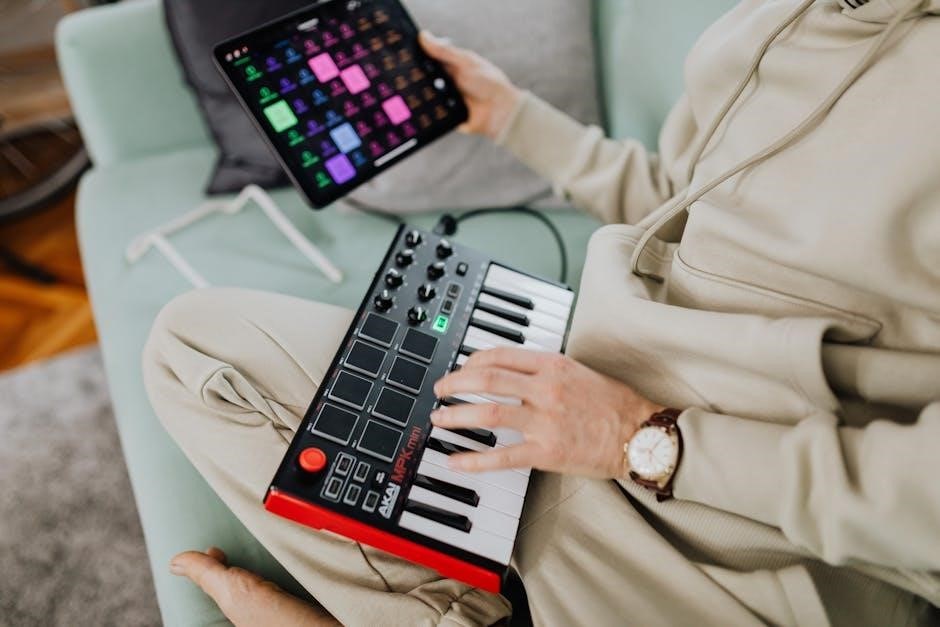Understanding MIDI Basics
MIDI (Musical Instrument Digital Interface) is a protocol enabling electronic instruments, computers, and related devices to communicate. It transmits musical performance data, such as note events, without audio signals. This allows for limitless sound customization using virtual instruments and effects. MIDI files are small, containing note values, timing, and tracks, making them ideal for composition and production. They revolutionized music creation by separating sound from performance, enabling precise editing and manipulation. MIDI is essential for producers, offering flexibility and creativity in music-making.

Setting Up Your Digital Audio Workstation (DAW)
Setting up your Digital Audio Workstation (DAW) is the first step in creating MIDI music. Start by choosing a DAW like FL Studio, GarageBand, or Logic Pro X, depending on your operating system and needs. Install the DAW and familiarize yourself with its interface, including the timeline and MIDI editor.
Connect your MIDI keyboard or digital piano via USB or MIDI ports. Configure the MIDI settings in your DAW to recognize the device; This ensures proper input and output routing. Explore virtual instruments and SoundFonts, which can be loaded into your DAW to play back MIDI data.
Understand the difference between MIDI and audio tracks. MIDI tracks control virtual instruments, while audio tracks record live sounds. Assign MIDI channels and ports correctly to avoid conflicts. For audio-to-MIDI conversion, use built-in tools or plugins within your DAW.
Avoid common mistakes like incorrect channel assignments or sync issues by following setup guides. Finally, organize your workspace and start creating by recording and editing MIDI performances. Proper DAW setup is crucial for a smooth MIDI-making experience.

Learning the MIDI Editor
Mastering the MIDI editor is essential for refining your musical ideas. This tool allows precise control over note placement, velocity, and timing. Start by understanding the piano roll view, where notes are displayed as colored bars on a grid. This visual representation makes it easy to edit performances.
Learn to navigate the MIDI editor’s interface, focusing on tools like the pencil for drawing notes and the hand for scrolling. Use quantization to align notes to a grid, ensuring rhythmic accuracy. Experiment with velocity adjustments to add dynamics to your music.
Edit MIDI data by resizing notes, adjusting start and end times, and modifying velocities. Use the MIDI editor to correct mistakes or enhance performances. For complex compositions, explore advanced features like MIDI effects and automation.
Practice regularly to improve your editing skills. The MIDI editor is a powerful tool for transforming raw ideas into polished tracks. By mastering it, you can achieve professional-sounding results in your music production.
Selecting SoundFonts
SoundFonts are essential for achieving high-quality sounds in your MIDI productions. They contain sampled instruments and sounds that your MIDI data triggers. To create professional-sounding music, it’s crucial to select the right SoundFont for your needs.
When choosing a SoundFont, consider the type of music you’re producing. For example, orchestral tracks require detailed, realistic instrument samples, while electronic music might benefit from synthetic or unique SoundFonts. Look for files with high-quality samples and realistic articulations.
SoundFonts are available in various formats, such as SF2 (SoundFont 2) and SFZ. Ensure your DAW or MIDI player supports the format you choose. Many DAWs, like FL Studio and Logic Pro X, include built-in SoundFont players or support third-party plugins.
Explore free and paid SoundFont libraries online. Websites like SoundFont Mirror and various music production forums offer a wide range of options. Paid SoundFonts often provide better quality and more detailed samples.
Preview sounds before loading them into your project. Listen for clarity, dynamics, and realism. Test the SoundFont with your MIDI data to ensure it matches your creative vision.
Once selected, load the SoundFont into your DAW or MIDI synthesizer. Some tools require manual loading, while others automatically detect and apply SoundFonts. Adjust settings like reverb and EQ to enhance the sound further.
Experiment with layering multiple SoundFonts to create unique textures. This technique is especially useful for building complex sounds or mimicking real-world instrument combinations.
By selecting the right SoundFont, you can transform your MIDI tracks into compelling, professional-sounding music. Take the time to explore and test different options to find the perfect fit for your productions.

Translating Audio to MIDI
Translating audio to MIDI is a powerful technique for converting recorded performances into editable MIDI data. This process is invaluable for producers, composers, and musicians looking to recreate or rework existing audio tracks. Whether you’re working with vocal recordings, instrumental performances, or even drum loops, converting audio to MIDI opens up endless creative possibilities.
There are two primary methods for translating audio to MIDI: manual transcription and automated conversion. Manual transcription involves listening to the audio and manually entering notes into a MIDI editor. While time-consuming, this method ensures accuracy, especially for complex or nuanced performances. Automated tools, such as Melodyne, Ableton Live’s “Warp to MIDI,” or online converters, analyze the audio waveform and generate MIDI data based on the detected pitches and rhythms.
When using automated tools, it’s essential to refine the results. Audio-to-MIDI conversion isn’t always perfect, and you may need to manually correct notes, adjust timings, or clean up artifacts. Additionally, consider the quality of the source audio—clear, isolated recordings yield better results than noisy or layered tracks.
Once you’ve translated audio to MIDI, you can edit the performance, change instruments, or layer sounds to create something entirely new. This technique is particularly useful for recreating classic tracks, learning from other artists, or incorporating live performances into your productions.
By mastering the process of translating audio to MIDI, you can breathe new life into your musical ideas and expand your creative toolkit. Whether you’re a producer, composer, or performer, this skill is a game-changer for modern music-making.
Avoiding Common Mistakes
When working with MIDI, it’s easy to fall into common pitfalls that can hinder your creative flow and the quality of your music. One of the most frequent mistakes is not properly setting up your MIDI ports and channels, which can lead to confusing routing issues. Additionally, many producers overlook velocity sensitivity, resulting in performances that lack dynamics and feel robotic.
Another common error is over-quantizing MIDI notes. While quantization can tighten up a performance, excessive use can strip away the human feel and make your music sound mechanical. Always aim for a balance by using quantization sparingly or adjusting it to a lower percentage for a more natural sound.
Layering too many MIDI tracks without proper organization is another mistake to avoid. This can clutter your project and make it difficult to edit individual parts later. Use folders or groups to keep related tracks organized, and label your MIDI clips clearly for easier navigation.
Ignoring the basics of MIDI editing is another oversight. Many producers skip learning essential tools like the piano roll editor, velocity editor, and MIDI effects, which are crucial for refining your performances. Take the time to master these tools, as they can elevate your MIDI work from basic to professional.
Finally, don’t forget to regularly backup your MIDI files and projects. Losing hours of work due to a technical glitch or accidental deletion can be devastating. By avoiding these common mistakes, you can ensure your MIDI productions are polished, professional, and full of life.

MIDI Channels and Ports
MIDI channels and ports are fundamental components of MIDI communication, enabling devices to send and receive data effectively. MIDI channels act as virtual pathways for musical data, allowing multiple instruments or sounds to be controlled independently within a single MIDI interface. Each of the 16 standard MIDI channels can be assigned to a specific instrument or function, making it easier to manage complex productions.
MIDI ports, on the other hand, are the physical or virtual endpoints through which MIDI data is transmitted. These ports can be found on MIDI interfaces, sound cards, or even within software. Understanding how to configure MIDI ports is essential for ensuring your devices communicate properly. For instance, a MIDI keyboard might send data through a specific port, which your DAW must receive to trigger virtual instruments.
A common mistake is confusing MIDI channels with ports. While ports handle the data transmission, channels organize the data itself. Properly labeling and organizing your MIDI channels and ports prevents routing issues and simplifies your workflow. Additionally, many modern DAWs support virtual MIDI ports, allowing you to route MIDI data between software applications without physical hardware.
When working with MIDI, it’s important to remember that a single MIDI interface can support up to 16 channels. If you exceed this limit, consider using multiple interfaces or leveraging software-based solutions. By mastering MIDI channels and ports, you can unlock the full potential of MIDI for creating and controlling your music productions.

Looping and Layering Techniques
Looping and layering are powerful techniques in MIDI production that enhance creativity and efficiency. Looping involves repeating a MIDI sequence to create rhythmic consistency or build upon a musical idea. This is particularly useful for drum patterns, basslines, or melodic motifs. By looping a section, you can focus on refining it before expanding your track.
Layering, on the other hand, involves combining multiple MIDI tracks to add depth and complexity. For example, you might layer a synth pad with a piano melody or combine percussion elements from different kits. This technique allows for rich, textured soundscapes that engage listeners.
To implement looping, most DAWs provide tools to select and repeat specific sections of your MIDI arrangement. Experiment with varying loop lengths and syncopation to create dynamic interest. For layering, use multiple MIDI channels or tracks to stack sounds, ensuring each layer complements the others without overwhelming the mix.
Practical tips include using software tools to simplify the process, such as looping markers or layering presets. Additionally, experiment with subtle variations within loops to maintain listener engagement. Layering can also be enhanced by assigning different MIDI channels to separate instruments, ensuring clarity and balance.
Mastery of these techniques can elevate your productions, enabling you to craft compelling and intricate music efficiently. Whether you’re creating beats, soundtracks, or experimental works, looping and layering are indispensable tools in your MIDI toolkit.

Using MIDI Effects
MIDI effects are powerful tools that allow you to manipulate and enhance MIDI data in real-time, adding depth and creativity to your music productions. Unlike audio effects, which process sound after it’s generated, MIDI effects alter the performance data before it reaches the instrument, enabling transformative changes to notes, timing, and dynamics.
One popular MIDI effect is the arpeggiator, which breaks down chords into sequential notes, creating melodic patterns. This is perfect for adding interest to synth lines or basslines without manual input. Another useful effect is the velocity editor or randomizer, which adjusts note velocities to introduce human-like variation, making robotic-sounding tracks feel more natural.
MIDI filters are also invaluable, allowing you to control which data reaches your instruments, such as filtering specific notes or controllers. This can help create unique effects or clean up tracks by removing unwanted data.
Most DAWs offer built-in MIDI effects, and there are also third-party plugins available. Experimenting with these can lead to rich, layered sounds. For instance, layering multiple effects can create complex textures, while applying them strategically can enhance specific tracks or the entire project.
Consider organizing effects in your workflow, whether per track or project-wide, to achieve desired results. The key is to use MIDI effects thoughtfully, avoiding overuse that might complicate your track. By understanding and creatively applying MIDI effects, you can elevate your productions and achieve dynamic, engaging music.

Exporting MIDI Files
Exporting MIDI files is a crucial step in music production, enabling you to share your compositions or use them in different projects. MIDI files contain performance data like notes, timing, and track information, making them lightweight and versatile. To export a MIDI file, most DAWs offer an option in the file menu under “Export” or “Render,” with MIDI as the format choice.
When exporting, consider the type of MIDI file: Type 0 combines all tracks into one, while Type 1 keeps tracks separate. Choose based on your needs for compatibility and editing. Ensure settings like PPQ (pulses per quarter note) match your project to maintain timing accuracy. It’s also wise to review the MIDI data for any unintended notes or errors before export.
Exporting MIDI files allows collaboration with others, as they can import and edit the data in their DAW. This is particularly useful for producers and composers who need to share their work. Additionally, MIDI files can be used in live performances or integrated into multimedia projects. Always organize your exported files in a dedicated folder for easy access and future reference.
Remember to back up your MIDI files regularly, especially if you plan to use them across multiple projects. This ensures your work is safe and readily available. By mastering the process of exporting MIDI files, you enhance your workflow and expand the possibilities for your music.

Finding MIDI Resources
Finding quality MIDI resources is essential for enhancing your music production skills and accessing a wide range of tools and files; Online forums like r/WeAreTheMusicMakers and Music: Practice & Theory Stack Exchange are excellent places to discover MIDI-related software, tutorials, and discussions. Websites such as MIDI.org provide comprehensive guides and specifications to deepen your understanding of MIDI technology.
For MIDI files, platforms like MIDI World and Midi-Files.de offer a vast library of free and premium MIDI tracks across various genres. These files are ideal for learning, practicing, or integrating into your projects. Additionally, communities like Gearslutz and KVR Audio host discussions and resources for MIDI controllers, software, and effects.
When searching for MIDI tools, use specific keywords like “MIDI editor,” “MIDI keyboard,” or “MIDI converter” to find software tailored to your needs. Tools like Ableton Live and FL Studio offer robust MIDI editing capabilities. Tutorials on YouTube channels such as The Pro Audio Files provide practical insights into MIDI production techniques.
Joining online communities and forums ensures you stay updated on the latest MIDI trends and tools. By leveraging these resources, you can enhance your MIDI-making skills and access a wealth of materials to inspire your creativity. Remember to explore multiple sources to find the best fit for your specific needs.
Regularly visiting these resources will help you stay informed about new software updates, MIDI standards, and innovative applications. This continuous learning will keep your productions fresh and aligned with industry advancements.

Selecting the Right Tools
Selecting the right tools is crucial for effective MIDI production. A Digital Audio Workstation (DAW) like FL Studio, Ableton Live, or Logic Pro X is essential for creating and editing MIDI files. Each DAW offers unique features, so choose one that aligns with your workflow and goals. For example, FL Studio is renowned for its piano roll editor, while Ableton excels in live performance and MIDI manipulation.
A MIDI keyboard or controller is another indispensable tool. Popular options include the Novation Launchkey and Akai MPK Mini. These devices allow you to input MIDI data directly into your DAW, enhancing creativity and precision. When selecting a MIDI controller, consider factors like key count, portability, and additional features such as pads or knobs.
Virtual instruments and SoundFonts are also vital for bringing your MIDI tracks to life. Plugins like Toontrack EZdrummer for drums or Xfer Serum for synths offer high-quality sounds. SoundFonts, such as those from SoundFonts.it, provide a wide range of timbres for your productions. Experiment with different tools to find the sounds that best match your creative vision.
Lastly, consider additional software like MIDI editors or utilities for advanced tasks. Tools like Mido or PyDub can streamline your workflow. Always research and compare features to ensure you’re using the best tools for your specific needs.
By selecting the right combination of hardware and software, you can unlock the full potential of MIDI and create professional-grade music productions.